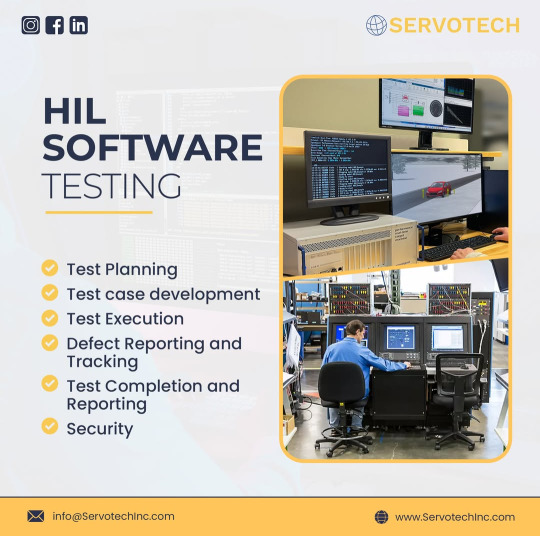#HILTesting
Explore tagged Tumblr posts
Text
Comprehensive Engineering Services by Servotech Inc.

In the dynamic landscape of modern engineering, the demand for specialized services that drive innovation and efficiency is paramount. Servotech Inc., a leading global technology services company, stands at the forefront of this evolution, offering a diverse array of engineering and IT solutions tailored to meet the unique needs of various industries. With a commitment to excellence and a track record spanning over two decades, Servotech Inc. has established itself as a trusted partner for organizations seeking to navigate the complexities of technological advancement.
Off-Site Engineering Services (SOW)
ServotechInc provides off-site engineering services, assembling expert teams to support clients' specific requirements. Similar to how law firms offer specialized legal counsel, Servotech delivers engineering expertise in areas such as mechatronics, embedded software development, and control system design. This approach allows clients to access top-tier engineering talent without the need for in-house resources, fostering innovation and efficiency.
On-Site Engineering Services
For projects necessitating close collaboration, Servotech offers on-site engineering services, embedding their teams within the client's work environment. This co-location strategy ensures seamless integration with the client's operations, facilitating real-time communication and problem-solving. Supported by senior technical members from Servotech's offices, these on-site teams receive continuous supervision and training, ensuring the delivery of high-quality solutions.
Technical Staffing Services
Recognizing the challenges organizations face in sourcing and retaining qualified engineers, Servotech provides comprehensive technical staffing services. The company identifies and trains engineers in required fields using state-of-the-art technology and real-life applications, then places them in suitable roles as per client needs. This service ensures that clients have access to skilled professionals capable of contributing effectively to their projects.
Specialized Engineering Fields
Servotech Inc. offers expertise across a broad spectrum of engineering disciplines, including.
Mobile Machine Control Systems: Design and implementation of control systems for mobile machinery, enhancing performance and safety.
Embedded Software Development: Creation of software solutions embedded within hardware systems, crucial for applications in automotive, aerospace, and consumer electronics.
PLC Programming using CODESYS: Development of programmable logic controller (PLC) applications utilizing the CODESYS platform, enabling efficient automation solutions.
Mechatronic Design: Integration of mechanical engineering, electronics, computer science, and control engineering to design and create intelligent systems and products.
Model-Based Design using MATLAB and Simulink: Utilization of MATLAB and Simulink for model-based design, allowing for simulation and analysis of systems before physical prototypes are developed.
HIL Software Testing: Implementation of Hardware-in-the-Loop (HIL) testing methodologies to validate and verify embedded control systems in real-time environments.
Autonomous Vehicle Control Systems: Development of control systems for autonomous vehicles, encompassing navigation, perception, and decision-making algorithms.
Precision Farming Technology: Application of technology to enhance agricultural practices, including the development of automated systems for planting, harvesting, and crop monitoring.
CAD/FEA Design and Analysis: Provision of Computer-Aided Design (CAD) and Finite Element Analysis (FEA) services to support product design and structural analysis.
Information Technology: Offering IT solutions that complement engineering services, ensuring seamless integration and support for various technological initiatives.
By offering these specialized services, Servotech Inc. addresses the multifaceted challenges faced by industries such as aerospace, automotive, agriculture, and more.
Commitment to Excellence and Innovation
Servotech Inc.'s dedication to excellence is evident in its recruitment and training practices. The company sources talent globally, emphasizing skills and expertise over geographical location. Virtual teams, connected through advanced internet technologies, collaborate effectively without physical limitations, bringing together the best talent from around the world. This approach fosters a culture of integrity, continuous learning, and innovation.
Global Reach and Collaborative Approach
With a presence in multiple countries, Servotech Inc. is positioned to assist clients worldwide with their engineering and IT needs. The company's collaborative approach involves partnering with clients to understand their unique challenges and delivering tailored solutions that drive success. This global reach, combined with a commitment to personalized service, makes Servotech a preferred partner for organizations seeking to navigate the complexities of modern engineering projects.
Conclusion
In an era where technological advancement is both rapid and imperative, Servotech Inc. stands as a beacon of expertise and reliability in the engineering services sector. Through its comprehensive suite of services, spanning off-site and on-site engineering support, technical staffing, and specialized engineering fields, Servotech empowers organizations to achieve their goals with precision and efficiency. By fostering a culture of excellence, innovation, and global collaboration, Servotech Inc. continues to drive progress and deliver value across industries.
#EngineeringServices#TechnicalStaffing#EmbeddedSoftware#MechatronicDesign#PLCProgramming#HILTesting#AutonomousVehicles#PrecisionFarming#FEAAnalysis#ModelBasedDesign
0 notes
Text
Top Career Opportunities in Automotive Engineering
The automotive industry is transforming with cutting-edge technologies like electric vehicles (EVs), autonomous vehicles (AVs), and software-defined vehicles (SDVs). High-demand roles include:
Functional Safety Engineer: Ensures compliance with ISO 26262 standards.
HIL Test Engineer: Validates systems using real-time simulations.
AUTOSAR Engineer: Develops scalable automotive software platforms.
These careers are thriving due to advancements in EVs and ADAS systems. Want to explore more? Visit DPIT Systems for insights into these exciting opportunities.

#AutomotiveCareers#ElectricVehicles#AutonomousVehicles#SoftwareEngineering#HILTesting#AUTOSAR#TechJobs2024
0 notes
Text
Hardware-in-the-Loop (HIL) Testing: Enhancing Embedded System Development

In the realm of embedded system development, ensuring that software and hardware components function seamlessly together is paramount. Hardware-in-the-Loop (HIL) testing has emerged as a pivotal methodology to achieve this integration, offering a bridge between virtual simulations and real-world hardware interactions. This approach not only enhances the reliability of embedded systems but also optimizes development timelines and costs.
Understanding HIL Testing
HIL testing is a technique where real hardware components are interfaced with simulated environments to test and validate embedded systems. By integrating physical hardware into a controlled simulation, engineers can evaluate system responses to various scenarios without the need for complete physical prototypes. This method allows for comprehensive testing of embedded software in conditions that closely mimic actual operational environments.
Key Components of HIL Testing
Real-Time Simulation: A core aspect of HIL testing involves real-time simulation of the system’s environment. This simulation replicates the dynamic behavior of the system, allowing the hardware to interact as it would in real-world conditions.
Electrical Emulation: HIL systems emulate electrical signals corresponding to sensors and actuators. This electrical emulation forms the interface between the simulated environment and the physical hardware, enabling accurate testing of the hardware’s response to various inputs.
Embedded System Under Test: The actual hardware component, such as an Electronic Control Unit (ECU), is integrated into the HIL setup. This hardware interacts with the simulated environment, allowing engineers to assess its performance and identify potential issues.
Advantages of HIL Testing
Early Detection of Errors: By simulating real-world conditions, HIL testing enables engineers to identify and rectify software errors before deploying the software onto actual hardware. This proactive approach minimizes the risk of system malfunctions and enhances overall software quality.
Cost and Time Efficiency: Traditional testing methods often require extensive physical prototypes, leading to increased development costs and extended timelines. HIL testing reduces the reliance on physical prototypes by providing a virtual testing environment, thereby streamlining the development process and reducing expenses.
Comprehensive Test Coverage: HIL testing facilitates the execution of a wide array of test scenarios, including those that may be impractical or unsafe to perform on actual hardware. This extensive test coverage ensures that the embedded system can handle diverse operational conditions effectively.
Enhanced Safety: For safety-critical applications, such as automotive or aerospace systems, HIL testing allows for the simulation of extreme conditions without endangering personnel or equipment. This capability is crucial for validating system responses to potential hazards.
Applications of HIL Testing
HIL testing is utilized across various industries to validate and verify embedded systems:
Automotive Industry: In automotive applications, HIL simulators provide a virtual vehicle environment for system validation and verification. This approach allows developers to validate new hardware and software solutions, ensuring quality and adherence to time-to-market constraints.
Aerospace Industry: HIL testing enables the simulation of flight conditions, allowing for the validation of avionics systems and control software without the need for actual flight tests. This methodology enhances safety and reduces testing costs.
Robotics: In robotics, HIL simulation techniques have been applied to the automatic generation of complex controllers. Robots use their own hardware to extract sensory and actuation data, which is then used to infer physical simulations, aiding in the development of robust control systems.
Power Systems: HIL testing is employed to verify the stability, operation, and fault tolerance of large-scale electrical grids. Real-time processing platforms can model extensive power systems, facilitating the evaluation and testing of these systems in a realistic emulated environment.
Implementing HIL Testing with Servotech Inc
Servotech Inc specializes in HIL software testing, offering services that enable engineers to test embedded software in virtual settings that closely mimic actual hardware environments. This approach allows for the early detection and resolution of software flaws, reducing the risk of system malfunctions, security hazards, and costly recalls.
Conclusion
Hardware-in-the-Loop testing by Servotech stands as a cornerstone in the development and validation of embedded systems. By integrating real hardware components with simulated environments, HIL testing offers a robust platform for early error detection, cost reduction, and comprehensive test coverage. As industries continue to evolve and systems become more complex, the role of HIL testing in ensuring the reliability and safety of embedded systems will undoubtedly become increasingly significant.
0 notes
Text
HIL software testing
Hardware-in-the-Loop (HIL) software testing is a critical technique in the development of embedded systems. It bridges the gap between software development and physical hardware testing by creating a controlled environment that simulates real-world scenarios. This approach allows engineers to validate and fine-tune software while ensuring the hardware's functionality aligns with the intended design.
What is HIL Testing?
HIL testing integrates software and hardware by connecting physical components, such as sensors and actuators, to a simulation model that represents the real-world system. The software under test interacts with this model as if it were the actual environment, allowing engineers to evaluate its performance, reliability, and accuracy in diverse conditions.
For example, in automotive applications, HIL setups can simulate driving scenarios like different terrains, weather conditions, or traffic situations. The software controlling the engine, brakes, or steering is tested in a virtual environment without risking safety or incurring high costs.
Key Benefits of HIL Testing
Enhanced Validation and Debugging:HIL testing provides a safe, repeatable, and cost-effective way to identify and rectify software bugs or integration issues before deploying systems into real-world applications.
Cost Efficiency:By testing software in a virtual environment, companies can avoid the expenses associated with building physical prototypes or conducting extensive field tests.
Time Savings:Simulations allow for faster testing cycles, enabling early detection of issues and reducing overall development timelines.
Safety Assurance:HIL testing ensures the system performs reliably in critical industries like aerospace, automotive, and medical devices, where failures can have significant consequences.
Applications of HIL Testing
HIL testing is widely used in various sectors:
Automotive: Testing advanced driver-assistance systems (ADAS), electronic control units (ECUs), and autonomous driving software.
Aerospace: Simulating flight dynamics for avionics systems and aircraft control software.
Energy: Validating control systems for renewable energy solutions like wind turbines and solar panels.
Robotics: Ensuring reliable operation of robotic arms, drones, and automated systems.
Conclusion
HIL software testing is an indispensable part of modern embedded system development. By enabling rigorous validation in a virtual yet realistic environment, it ensures higher software quality, reduced development costs, and safer products. As technology evolves, HIL testing will remain a cornerstone of innovation across industries.
#HILTesting#SoftwareTesting#EmbeddedSystems#HardwareInTheLoop#AutomationTesting#SystemValidation#ControlSystems#SimulationTesting#AutomotiveTesting
1 note
·
View note